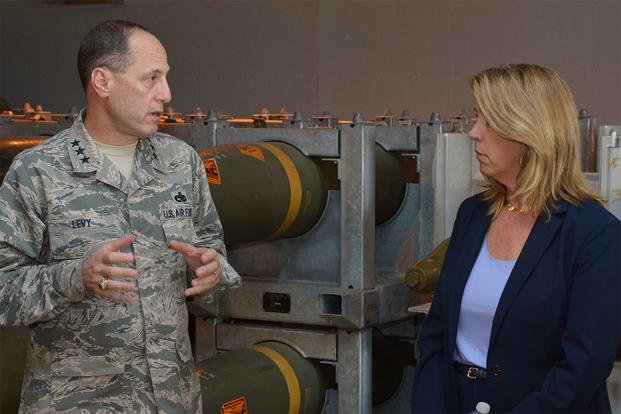HILL AIR FORCE BASE, Utah -- Air Force Secretary Deborah Lee James visited Hill Air Force Base, July 23-24, for the first time since taking the on the job a year and a half ago.
James' visit included updates on the transition from the F-16 Fighting Falcon to the F-35 Lightning II, the total force integration of the active-duty and Reserve 388th and 419th Fighter Wings, F-35 and missile depot maintenance, Hill AFB’s global munitions deployment capability, and cost effectiveness programs helping the Air Force "Make Every Dollar Count."
On the second day of her visit, James held an all call for Airmen, military and civilian, to share her priorities for the Air Force and address emerging issues.
James said she and Air Force Chief of Staff Gen. Mark A. Welsh III are leading the service at a difficult time.
The service has been stripped of 200,000 people over the past 20 years and is smaller than it's been since 1947, James said. The average aircraft in the Air Force fleet is 27 years old.
According to James, the "world is exploding," and according to commanders, about half of the Air Force combat forces are not currently capable of delivering in a "high-end."
All of these factors combine to put the Air Force and its people under a great amount of stress, which is why taking care of Airmen is her first priority, James said.
"I'm convinced if you get the people part right, the rest will follow," James said.
While the budget continues to be an issue of contention between the service heads and Congress, James said they have no trouble finding agreement on quality of life and pay issues for Airmen.
There is one exception. A congressionally proposed change to the housing allowance rates for military-to-military marriages along with Airmen who choose to room together, the change would strip the lower ranking member in the relationship of a significant portion of their allowance.
"We're against it. The senior enlisted advisors have all written to Congress about it,” James said. “I've been very vocal about it. We're fighting it. I don't have a good feel for how this is going to come out, but rest assured we're being vocal about this being harmful and frankly, unfair."
On the civilian side, James said she does not foresee the civilian workforce being furloughed again if the budget remains unresolved.
Related Video:
"We would never do that of our own volition. ... I'm only a piece of the whole equation, but I'm certainly not a proponent of that. General Welsh is not a proponent of that," the secretary said.
The Air Force is the only service that has met the Defense Department requirement to cut their military and civilian headquarters staff (all units above wing level) by 20 percent, and is hoping for some congressional goodwill in any potential future cuts, James said.
Financial strain is part of the new reality in a DOD that's being asked to cut $1 trillion over the next decade. James' second priority is using resources to "balance the readiness needs of today with the needs of tomorrow.
"We can't do one or the other. We've got to do both," she said.
In order to provide for both of these needs, the Air Force has proposed to retire older aircraft over time -- including the Hill AFB-maintained A-10 Thunderbolt II -- and transfer the people and resources to more modern aircraft.
If Congress does not allow the Air Force to retire the A-10 it will become an "unfunded liability," siphoning people and resources away from modern weapons systems, James said. While the A-10 is beloved, the F-16 and the F-35 can serve in more diverse mission sets.
"This is an area where Congress simply does not agree with us. They want us to keep the A-10." James said.
Retiring the A-10 would save $4 billion over five years. That's $4 billion toward modernizing the fleet with the F-35, KC-46 Pegasus, and the Long Range Strike Bomber program coming online -- as well as space, cyber and nuclear enterprises, James said.
"I'm asking Congress to give us the money, and the flexibility we need to manage this very complex Air Force," James said.
In this resource constrained environment, it's crucial to make every dollar count, and the Air Force-wide, cost-savings program is the third priority James highlighted.
"We are stewards of the taxpayer's money," James said. "We have to keep new programs on time and on budget. We have to march toward the auditability of our books in the DOD. ... We're looking for savings everywhere."
At Hill AFB, the secretary praised the Enhanced Use Lease program which allows the Air Force to partner with private developers to enhance underutilized DOD land.
She also praised the implementation of the “Air Force Sustainment Center Way” at the Ogden Air Logistics Complex, where repeatable processes from other depots and industry partners are shared and put into place as best practices.
"This allows (the depot) to deliver products to the warfighter at less cost and quicker," James said. "We have to keep charging in that regard."






























